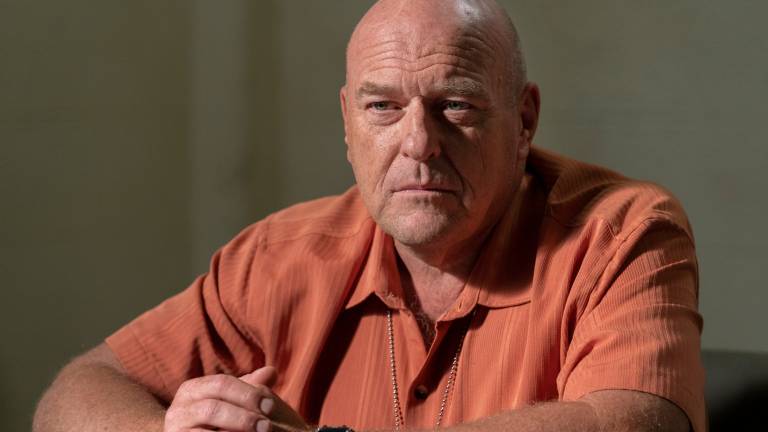Better Call Saul Season 5: Why Hank Returned
Hank is the latest Breaking Bad player introduced to Better Call Saul. What does season 5 have in store for him?

The following contains spoilers for Better Call Saul season 5 episode 3.
In the middle of a mostly gloomy episode of Better Call Saul “The Guy For This,” which solidifies Jimmy’s involvement with the Salamancas and finds Kim playing the villain in a corporate lawsuit, a ray of sunshine appears. Or perhaps a ray of sunshine is reflected off of one returning hero’s chrome dome. The DEA’s Assistant Special Agent in Charge, Hank Schrader, has reentered the Breaking Bad universe with his ever-reliable partner Steve Gomez in tow. It’s Dean Norris and Steven Michael Quezada’s first official appearances in the prequel series and their first time reprising their characters since their deaths in “Ozymandias.”
This isn’t the first time that fan-favorite characters from Better Call Saul’s parent series have made a belated debut. We didn’t hear wheelchair-bound Salamanca family mastermind Hector ring his bell until Better Call Saul Season 2, and wolf in sheep’s clothing Gus Fring wasn’t called in to add a spark to Saul until Season 3. However, there are times that these nods to the original series can feel more obligatory than necessary. Especially as the series has gone along, Jimmy and Mike’s storylines have diverged drastically with very little crossover. Sometimes it can feel as if Mike’s story, which has him interacting with characters and elements that feel much more familiar to Breaking Bad devotees, is only there to supply the fan-service needed to keep a certain subset of the audience tuning in.
There’s a way to bring a character back in a prequel that feels purposeful; our understanding of Mike, of the grief he carries due to the death of his son, has deepened considerably through Better Call Saul and reshapes the character and his actions when rewatching Breaking Bad. That being said, our perspective on Gus has not changed. He shows up to act menacing, make you worry about Nacho’s well-being, and little else. We’ve learned almost nothing new about Gus, which makes his appearance on the show feel akin to eating candy; it tastes good, but it isn’t really fulfilling (on one hand, there’s still plenty of time for Peter Gould and company to make me eat my words here, on the other hand, there’s El Camino, which proves there’s precedent for competent, somewhat hollow retreads in this universe).
Thankfully, Hank and Gomie’s entrance at this point in the series at least makes a lot of narrative sense. With Gus and Lalo’s crews looking to disrupt each other’s cash flows, it checks out that their shenanigans would cause them to register on the DEA’s radar. Lalo enlists Jimmy McGill to represent Krazy-8 and instruct him to deliver a very specific message to the police and become a criminal informant in hope of a reduced sentence. Instead of bringing in some faceless suits to receive that message, why not utilize two agents that a large portion of the audience already is familiar with? Also, it gives the actors a chance to reunite with a lot of the crew they worked alongside for a long time.
Speaking of Dean Norris’ return to the Breaking Bad universe, star Bob Odenkirk said “For me the show didn’t end. Breaking Bad stopped and then we started Better Call Saul. It was in the same place with the same crew but with different sets and different aspects to the character. I think Dean had a more interesting experience, having left the show and in his mind and his heart feeling like, ‘Well, that’s over,’ then being surprised to find himself back there. A lot of the same crew still, even five years in – 40% of our crew was Breaking Bad people. That’s a lot of people to carry this far into the future. Dean was the one who had a remarkable experience and I was happy to see him again.”
Hank and Gomie will presumably mostly remain as lawmen on the periphery, instead of frequent POV characters, and that’s how they likely should be used. Hank was given as full of a character arc as anyone on Breaking Bad, and thus there isn’t mainly places you can go with the guy in a prequel. Whereas Gus and Mike were a bit enigmatic in Breaking Bad, Hank was an open book. He was a cocky, boisterous agent whose insensitivity masked an insecure side. Hank then was humbled by violence, forcing him to rebuild his confidence and rethink his macho posturing. The Hank we find in Better Call Saul is the jokey man’s man from the early days of Breaking Bad, not the reclusive, contemplative mineral man he became. All of the character development happened on the other show, therefore we’re unlikely to learn anything new that changes our understanding of Hank.
Maybe this could be considered more fan service, but an onscreen authority figure is a great, logical added foil for not only the Gus and Lalo storyline, but for Jimmy to outsmart during his race to the bottom. This isn’t like Walt or Jesse appearing just for the hell of it, this is the show reminding us that there are legal repercussions for everyone involved in the cartel storyline, which now includes our lead character. Why not make the face of those consequences a familiar one?
